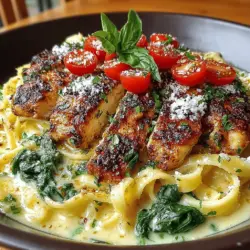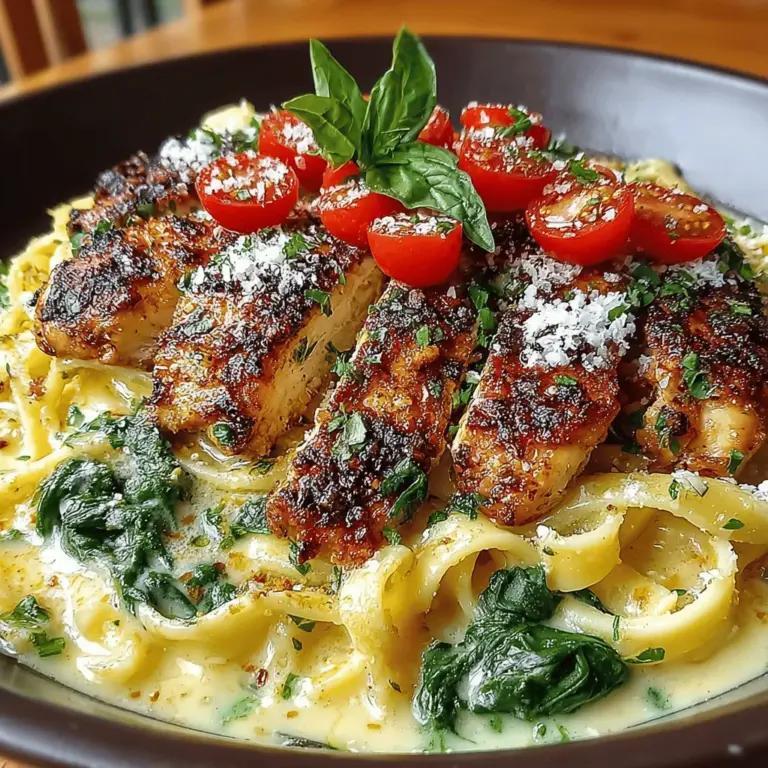Introduction
Tuscan Chicken Alfredo Fettuccine is a delightful embodiment of Italian comfort food, effortlessly blending rich flavors with a creamy texture that appeals to both pasta enthusiasts and casual diners alike. This dish, rooted in the culinary traditions of Tuscany, has garnered immense popularity across various dining settings, from intimate family dinners to elegant gatherings. Its versatility makes it an ideal choice whether you’re hosting friends or seeking a cozy meal for yourself.
The allure of Tuscan Chicken Alfredo Fettuccine lies in its harmonious balance of flavors and textures. The creamy Alfredo sauce envelops perfectly cooked fettuccine, while succulent chicken and vibrant vegetables add depth to each bite. Together, they create a satisfying dish that is as enjoyable to prepare as it is to savor.
Understanding Tuscan Cuisine
To appreciate Tuscan Chicken Alfredo Fettuccine fully, it’s essential to delve into the culinary traditions of Tuscany. Known for its rustic charm and emphasis on simplicity, Tuscan cuisine celebrates the use of fresh, high-quality ingredients. This approach is not merely a trend but a philosophy deeply rooted in the region’s history and agricultural practices. Tuscan chefs prioritize seasonal produce, locally sourced meats, and aromatic herbs, creating dishes that are both flavorful and nourishing.
Common ingredients found in Tuscan cuisine include robust olive oil, sun-ripened tomatoes, fragrant garlic, and an array of fresh herbs like basil and rosemary. These ingredients are often featured prominently in various dishes, allowing the natural flavors to shine through. Tuscan Chicken Alfredo Fettuccine exemplifies these culinary principles, showcasing the use of fresh chicken, creamy sauce, and vibrant vegetables that mirror the essence of Tuscany itself.
Ingredients Breakdown
A successful Tuscan Chicken Alfredo Fettuccine relies on the quality and selection of its ingredients. Each component plays a crucial role in creating the dish’s signature flavor profile. Here’s a breakdown of the key ingredients used in this recipe:
Chicken: The backbone of this dish, quality chicken is essential. Opt for boneless, skinless chicken breasts for their tenderness and ease of preparation. When cooked properly, the chicken should be juicy and flavorful, complementing the creamy Alfredo sauce. Consider marinating the chicken in herbs and spices to elevate its taste.
Heavy Cream: This ingredient is pivotal for achieving the rich and velvety consistency of the Alfredo sauce. Heavy cream not only adds creaminess but also helps to create a luxurious mouthfeel that coats the fettuccine beautifully. It’s important to use fresh heavy cream for the best flavor and texture.
Parmesan Cheese: Authenticity in flavor comes from the cheese used in the sauce. Grated Parmigiano-Reggiano is the gold standard for this recipe, offering a nutty and slightly sharp taste that enhances the overall profile of the dish. For the best results, freshly grate the cheese rather than using pre-packaged options, as this ensures a smoother integration into the sauce.
Fettuccine: This flat, thick pasta is ideal for Alfredo sauces due to its ability to hold onto creamy textures. The surface area of fettuccine allows the sauce to cling well, ensuring that every bite is filled with flavor. Cooking the pasta to al dente is crucial to maintain a satisfying bite and prevent it from becoming mushy.
Vegetables: Adding cherry tomatoes and spinach not only provides a burst of color but also brings additional nutrients and flavors to the dish. The sweetness of roasted cherry tomatoes contrasts beautifully with the richness of the Alfredo sauce, while spinach adds a subtle earthiness that balances the overall profile.
Step-by-Step Preparation
Now that we’ve explored the essence of Tuscan Chicken Alfredo Fettuccine and its key ingredients, let’s dive into the preparation process to ensure your dish turns out perfectly every time.
Cooking the Pasta: Begin by bringing a large pot of salted water to a boil. Salting the water is essential as it enhances the flavor of the pasta. Once the water reaches a rolling boil, add the fettuccine and cook according to package instructions, usually around 8-10 minutes, until it reaches an al dente texture. To achieve this, taste the pasta occasionally during the final few minutes of cooking.
Make sure to reserve about a cup of pasta water before draining the fettuccine. This starchy water can be added to the sauce later to adjust its consistency and help it adhere to the pasta seamlessly.
Preparing the Chicken: While the pasta cooks, it’s time to focus on the chicken. Begin by seasoning the boneless, skinless chicken breasts with salt, pepper, and any additional herbs or spices you prefer, such as garlic powder or Italian seasoning. In a large skillet, heat a tablespoon of olive oil over medium-high heat. Once the oil is hot, add the chicken breasts to the skillet.
Cook the chicken for about 6-7 minutes on each side, or until it reaches an internal temperature of 165°F and is golden brown on the outside. After cooking, remove the chicken from the skillet and let it rest for a few minutes before slicing it into strips. This resting period allows the juices to redistribute, ensuring the chicken remains tender and juicy when served.
With these foundational steps complete, you’re well on your way to crafting a delicious Tuscan Chicken Alfredo Fettuccine that will delight your family and friends. The next phase will involve creating the creamy Alfredo sauce and bringing all the elements together for a culinary experience that truly embodies the heart of Tuscan cuisine.
{{image_2}}
Seasoning Tips and Cooking Methods for Achieving a Golden Crust
Creating that perfect golden crust on your chicken is essential for both flavor and presentation. Start by seasoning your chicken breasts generously with salt, pepper, and your choice of herbs. A blend of Italian seasoning, garlic powder, and paprika can add depth and warmth to the chicken. Let the chicken sit at room temperature for about 15-20 minutes after seasoning; this allows the flavors to penetrate the meat better.
When it comes to cooking, use a heavy-bottomed skillet or cast-iron pan. Heat the pan over medium-high heat until hot, then add a tablespoon of olive oil. The oil should shimmer but not smoke. Place the chicken breasts in the pan, taking care not to overcrowd them, as this can cause steaming instead of searing. Cook for about 6-7 minutes on one side without moving them; this helps develop that golden crust. Once it’s well-browned, flip the chicken and cook for another 5-6 minutes until the internal temperature reaches 165°F (75°C).
Resting the Chicken for Optimal Juiciness and Flavor
After cooking, it’s vital to let your chicken rest for at least 5-10 minutes before slicing. This resting period allows the juices to redistribute throughout the meat, resulting in a more flavorful and tender chicken. Cover the cooked chicken loosely with foil to keep it warm while it rests. This simple step can make a significant difference in the overall texture and taste of your dish.
Crafting the Alfredo Sauce
Techniques for Sautéing Garlic and Achieving the Right Sauce Texture
The Alfredo sauce is the heart of this dish, and mastering it is crucial. Start by melting a generous amount of unsalted butter in the same skillet used for the chicken over medium heat. Add minced garlic and sauté for about 1-2 minutes until fragrant, but be careful not to burn it, as burnt garlic can impart a bitter taste to your sauce.
Next, pour in heavy cream and bring it to a gentle simmer. Allow the cream to reduce slightly for about 5 minutes, stirring occasionally to prevent it from sticking to the bottom of the pan. For that creamy, velvety texture, add freshly grated Parmesan cheese gradually, stirring continuously until it melts completely. If the sauce feels too thick, a splash of pasta water can help adjust the consistency.
The Role of Nutmeg and Other Spices in Enhancing Flavor
Nutmeg is an essential ingredient that elevates traditional Alfredo sauce, giving it a subtle warmth. A pinch of freshly grated nutmeg can enhance the creamy flavors and add an aromatic touch that sets your sauce apart. Additionally, consider incorporating a dash of white pepper for a hint of heat without overpowering the dish. Taste the sauce as you go and adjust the seasoning with salt and pepper as necessary.
Combining All Elements
Tips for Folding in Vegetables and Ensuring Even Sauce Distribution
Once your sauce is ready, it’s time to bring all the elements together. Add the cooked fettuccine directly to the skillet with the sauce, tossing gently to coat the pasta evenly. If you’re adding vegetables like sun-dried tomatoes, spinach, or broccoli, fold them in at this stage. Make sure the vegetables are pre-cooked; they should be tender yet vibrant. This will ensure that every bite is filled with flavor.
To achieve a harmonious blend, consider using tongs to toss the pasta and sauce together gently, ensuring that every strand is coated without breaking the fettuccine.
Presentation and Serving Suggestions
Ideas on Serving Styles that Enhance the Dish’s Appeal
Presentation is key to making any dish more appetizing. For serving Tuscan Chicken Alfredo Fettuccine, choose wide, shallow bowls that allow the pasta to spread out. This not only looks attractive but also makes it easier to enjoy the dish. Twirl the pasta into a nest-like shape in the center of the bowl, then arrange slices of the rested chicken on top.
Importance of Bowl Choice and Garnishing with Fresh Basil
A sprinkle of freshly chopped parsley or basil adds a pop of color and freshness to the dish. For an extra touch, shave some additional Parmesan cheese over the top just before serving. This not only enhances the flavor but also gives a gourmet look to your meal.
Suggestions for Pairing with Wines or Side Dishes for a Complete Meal Experience
When it comes to pairing, a crisp white wine like Pinot Grigio or Chardonnay complements the creamy Alfredo sauce beautifully. If you prefer red, a light-bodied Chianti can also work well. For side dishes, consider a simple arugula salad dressed with lemon vinaigrette or garlic bread to soak up the delicious sauce.
Nutritional Insights
Overview of the Nutritional Profile of the Dish
Tuscan Chicken Alfredo Fettuccine is a rich and satisfying meal. On average, a serving contains approximately 650-800 calories, depending on portion sizes and added ingredients. The macronutrient breakdown typically includes:
– Protein: Around 35-40g (from chicken and cheese)
– Carbohydrates: Approximately 60-70g (from fettuccine)
– Fats: Roughly 30-40g (mainly from cream and butter)
Discussion on the Balance of Protein, Fats, and Carbohydrates
This dish provides a balanced mix of protein, fats, and carbohydrates, making it a hearty meal that can fuel you throughout the day. The protein from the chicken helps in muscle repair, while the carbs from pasta provide energy. However, due to its richness, it is best enjoyed in moderation, especially for those watching their caloric intake.
Considerations for Dietary Restrictions or Modifications
For those with dietary restrictions, consider these modifications to make the dish lighter or suitable for other diets:
– Lighter Alternatives: Use half-and-half or low-fat milk instead of heavy cream to reduce calories and fat content.
– Gluten-Free Options: Swap regular fettuccine with gluten-free pasta made from rice, quinoa, or lentils, ensuring everyone can enjoy this delightful dish.
Conclusion
Tuscan Chicken Alfredo Fettuccine is not just a meal; it’s an experience that captures the warmth and richness of Italian cuisine. The combination of juicy chicken, creamy Alfredo sauce, and perfectly cooked pasta creates a comfort food classic that can be easily made at home.
By taking your time with each step—from seasoning and cooking the chicken to crafting the sauce and presenting the dish—you can elevate your culinary skills and create a meal that will impress family and friends. Don’t hesitate to get creative with your ingredients and make this recipe your own. Enjoy the process of cooking, and savor every bite of this delicious dish!


